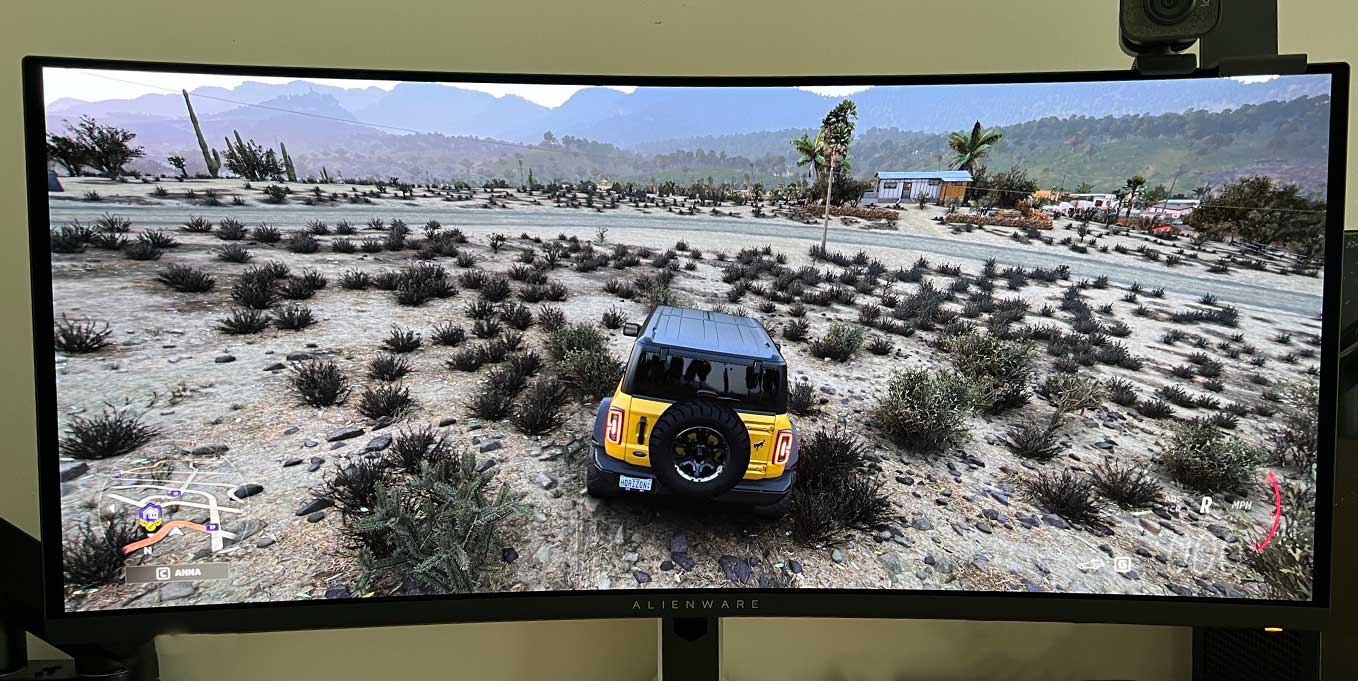I’ve always been a bit torn on ultrawide monitors. On one hand, they create an immersive gaming experience like no other, but for productivity, I’d always prefer two screens. The Dell Alienware 34″ QD-OLED is definitely the most tempted that I’ve been to rock an ultrawide full time, due to its QD-OLED display and great HDR performance.

When it comes to the design, it almost looks like this monitor takes design cues from the PS5 with its mix of white and blacks to really look futuristic. It’s got a 1800R curve which is pretty standard for ultrawide gaming and probably just the right amount of curve without it feeling like the monitor is taking up too much desk space. There’s RGB lights on the back, power button, logo and other parts of the monitor which can all be changed or turned off completely using the OSD.
WHERE TO BUY: DEALL FOR $2,299 AUD (GOES AS LOW AS $1600 OCCASIONALLY)
As far as ports go, there is one DisplayPort, two HDMI ports and a four port USB hub. It’s worth mentioning that the ports aren’t HDMI 2.1, which will mean there will be limitations if using a HDMI cord. You’ve got a power button on the right and an easily controlled OSD by use of a little joystick thats in the centre of the screen at the bottom and provides an easy way to adjust all the settings that you need.

The setup of this monitor is insanely easy, with you simply needing to click it into a stand and twist a little screw with your fingers, you’re able to swivel the monitor from left to right and also put it higher or lower on the stand easily.
If you’re an avid gamer, it’s absolutely no secret at this point that OLEDs are the best for gaming, but we just haven’t seen them in monitors (outside of the LG C1 OLED), but not only has Alienware gone and put an OLED display in this monitor, but it has gone a step further and put a QD-OLED in its display, so not only do you get the perfect blacks, you’ll also theoretically get a brighter display. We’ve only seen this tech in the new Samsung QD-OLED that has launched in America, and I believe this is the first and only monitor to use the tech so far.

Straight away when booting up the monitor, and going straight to a YouTube video, I’m amazed with how inky the blacks are you. You always realise just how grey blacks can look once you look at an OLED display, so from that point of view, if you’re somebody who owns an OLED TV and want that same experience for gaming, then this makes sense as an upgrade. One of the first things I watched on this monitor was the new God of War Ragnarok trailer and as soon as I saw that PlayStation Studios logo which is about as harsh as a test as they come (with a white logo on a pitch black screen), I was reminded just how impressive an OLED is.

The Alienware 34″ QD-OLED can reach a peak brightness of 1000 nits which whilst is still on the entry level side in TV land, is incredibly high compared to almost all monitors on the market, and right where you’d want to be to even bother with HDR in a PC space. Really this is the point at which you’re really being able to take advantage of HDR, and then once you pair that with the inky blacks of an OLED, it is a premium PC gaming experience. This is without doubt the best HDR experience I’ve had with a monitor, and I hope it’s the beginning of brighter panels across the board.

Playing games such as God of War, Horizon Zero Dawn or Resident Evil 3 felt like a brand new experience whilst playing them using this monitor. Not only did I feel that the QD-OLED display provided better blacks and brighter/more vivid colours than what I’m used to, this paired with the ultrawide 3440×1440/175Hz display took it to the next level. Obviously, the one downside to spending over $2,000 on a monitor like this is that it’s not going to be great for your PS5/Xbox Series X if you’re wanting to use it for console gaming. These consoles can’t take of the ultrawide display and it’s not a 4K monitor, so you’re missing out on that aspect too.
Obviously, whilst Windows is still making good strides in terms of HDR implementation, it’s still not great when using it outside of gaming, but this is a Windows problem and not on this fantastic performing monitor at all. The monitor has smart HDR built in meaning it can detect when HDR input is being received and turn it on and off accordingly.

It’s worth mentioning that given this is an OLED monitor, and the fact that you’re using it with PC elements that will remain on screen there is a pixel refresh feature that will slightly move all the elements on screen to ensure you don’t get burn-in. This feature pops up automatically every so often and I’d recommend using it. Another thing that I noticed (and has been a gripe with other OLEDs that I’ve used) is that the screen is quite reflective, especially when using it in a bright room with dark scenes.